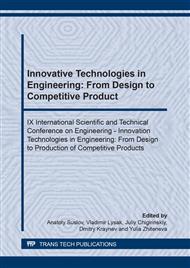[1]
Delan Yin, Shizhong Qiang, Influence of residual stresses and deformation on buckling behaviour of plates, Mechanical effects of welding, International Union of Theoretical and Applied Mechanics, (1992).
DOI: 10.1007/978-3-642-84731-8_27
Google Scholar
[2]
M. Adak, C. Guedes Soares, Effects of different restraints on the weld-induced residual deformations and stresses in a steel plate, The International Journal of Advanced Manufacturing Technology. 71-1 (2014) 699–710.
DOI: 10.1007/s00170-013-5521-9
Google Scholar
[3]
I. Birger, G. Iosilevich, B. Shorr, Calculation of the strength of machine parts: directory, Mechanical Engineering, (1993).
Google Scholar
[4]
A N Petukhov, High-cycle fatigue of materials and parts of gas-turbine engines, Strength of Materials. 37 (2005) 231-242.
DOI: 10.1007/s11223-005-0035-9
Google Scholar
[5]
A N Petukhov, Problems of the high-cycle fatigue of the materials intended for the parts of modern gas-turbine engines and power plants, Russian Metallurgy.10 (2010) 973-978.
DOI: 10.1134/s0036029510100174
Google Scholar
[6]
A.A. Matalin, I.P. Moiseev, Distortion of thin-walled pieces during relaxation of residual stresses, Metal Science and Heat Treatment.8-11 (1966) 883–886.
DOI: 10.1007/bf00652884
Google Scholar
[7]
M.E. Blanter, Theory of heat treatment, Moscow: Metallurgy, (1984).
Google Scholar
[8]
I.I. Novikov, Theory of heat treatment of metals, 4th ed., M.: Metallurgy, (1986).
Google Scholar
[9]
A.M. Chistyakov, A V Korolev, V.A. Krivego, V.G. Moiseev, Vibroaging method of parts, RU Patent. 2140842, N.8 (1999).
Google Scholar
[10]
N. Chawla, J.L. Stewart, J.J. Williams, Influence of thermal aging on the microstructure and mechanical behavior of dual-phase, Precipitation-Hardened, Powder Metallurgy Stainless Steels. Metallurgical and Materials Transactions. 43-1 (2012) 124–135.
DOI: 10.1007/s11661-011-0844-3
Google Scholar
[11]
E.G. Astafurova, V.M. Chernov, M.V. Leontyeva-Smirnova, I.Yu. Litovchenko, E.M. Mozhanov, N.S. Nikolaeva, N.A. Polekhina, A.N. Tyumentsev, Thermal stability of the microstructure of 12% chromium ferritic–martensitic steels after long-term aging at high temperatures, Technical Physics. 61-2 (2016) 209–214.
DOI: 10.1134/s1063784216020092
Google Scholar
[12]
M. Ghayour, R.M Homami, M.J. Vardanjani, Analysis of the vibration stress relief for reducing the residual stresses caused by machining, Experimental Techniques.40-2 (2016) 705–713.
DOI: 10.1007/s40799-016-0071-3
Google Scholar
[13]
R. Dawson, D.G. Moffat, Vibratory stress relief: a fundamental study of its effectiveness, Journal of Engineering Materials and Technology. 102-2 (1980) 169–176.
DOI: 10.1115/1.3224793
Google Scholar
[14]
O. Černašejus, M. Lech-Grega, A. Jaskiewicz, A. Jurčius, K.J. Kurzydlowski, A.V. Valiulis, Influence of vibratory stress relief on residual stresses in weldments and mechanical properties of structural steel joint, Journal of Vibroengineering. 12-1 (2010) 133-141.
DOI: 10.3846/bjrbe.2011.31
Google Scholar
[15]
A. Tsvetkov, Y. Solntsev, Influence of low-frequency treatment on the mechanical properties and internal stress of weld-seam metal in structural steel, Steel in Translation. 38-7 (2008) 531–532.
DOI: 10.3103/s0967091208070085
Google Scholar
[16]
K. Ragulskis, B. Stulpinas, K. Tolutis, Vibration aging, Moscow: Mashgiz, (1987).
Google Scholar
[17]
E. Kocherov, V. Radchenko, M. Saushkin, V. Smyslov. Experimental and theoretical studies of the influence of a tensile load on the relaxation of residual stresses in a hardened cylindrical specimen under creep conditions, Journal of Applied Mechanics and Technical Physics, 56-2 (2015) 313-320.
DOI: 10.1134/s0021894415020170
Google Scholar
[18]
A.F. Balaev, A.A. Korolev, A V Korolev, A.S. Yakovishin, Method of treatment of the parts rings by continuous running three rollers. RU Patent 2583520, N.13 (2016).
Google Scholar
[19]
A.F. Balaev, A.A. Korolev, A.V. Korolev, S.A. Savran, A.S. Yakovishin, Experimental study of residual stresses relaxation in ring details during multicyclic loading, IOP Conference Series: Materials Science and Engineering.156-1 (2016).
DOI: 10.1088/1757-899x/156/1/012011
Google Scholar
[20]
A.F. Balaev, B.M. Brzhozovskii, O.V. Zakharov, O.V., Kinematic and force factors in centerless superfinishing, Stanki Instrum. 11 (2006) 2–5.
Google Scholar
[21]
A.F. Balaev, A.V. Kochetkov, A.A. Korolev, A.V. Korolev, O.V. Zakharov, Modeling the mechanism of stress relaxation of ring parts at high-cycle loading, Proceedings of 2015 International Conference on Mechanical Engineering, Automation and Control Systems, MEACS 2015.(2015)1-4.
DOI: 10.1109/meacs.2015.7414977
Google Scholar


